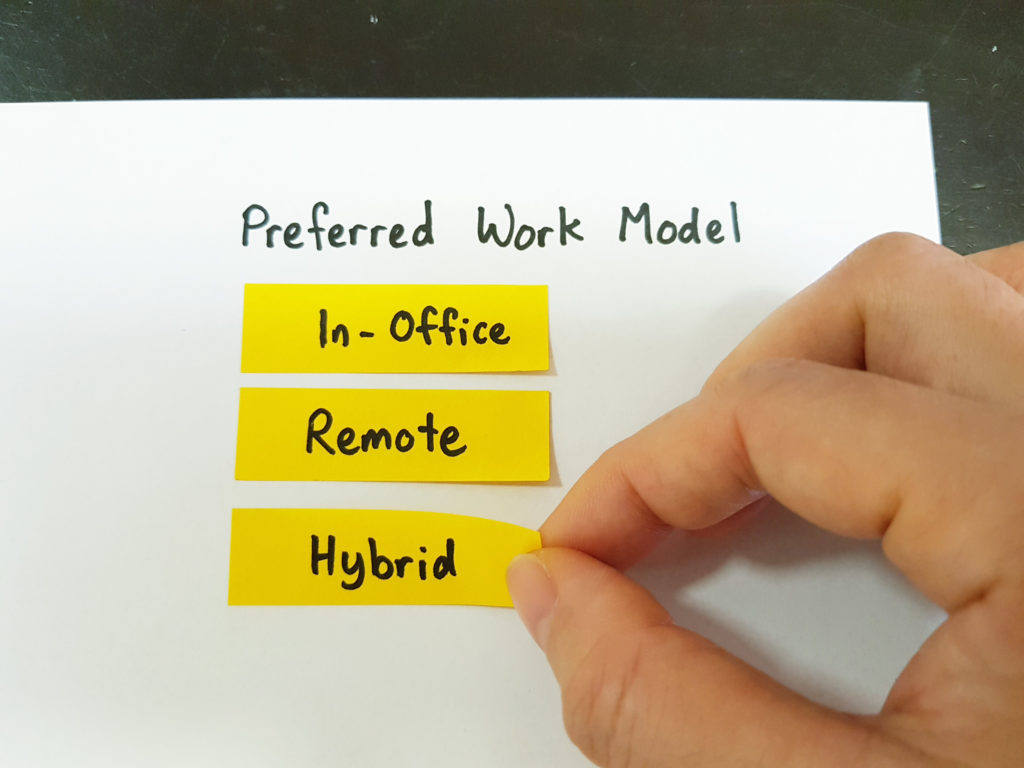- 12 May 2022
- Jeff Glazer
Would you take a pay-cut to work from home full-time by say 20%?
For the employees at one law firm in the UK, that’s exactly what’s happening. London-based Stephenson Harwood law firm has given permission to its 1,100 + employees across the globe to (continue) to work from home – but for a 20% pay cut”. 1
How much is that worth to you?

Working from home allows you to enjoy the benefits and comfort of flexible work, like not having to chase the train or getting stuck in traffic, sleeping-in a little longer, working from your sofa-bed, wearing your track-pants. But, what if, to do so, you had to cop a cost?
If you’re an employer, would you place a premium on the flexible work option?
Interesting and somewhat controversial no doubt: putting a price on working from home.

This UK example, recently reported in The Guardian, is typical of how some companies across the world are trying to adapt to a post-pandemic world of flexible work arrangements.
According to The Guardian’s report, the firm is currently implementing a hybrid work option where employees are permitted to work remotely for two days a week, but for a price.
Under its new hybrid and remote working policy, which took effect this month, full-time workers from this law firm must be in the office at least 60% of the time – unless they opt to sacrifice some of their salary for a full remote working contract. As can be expected, there’s been push-back from employees.
Partners are excluded from this arrangement.
Is the idea of docking pay for the privilege of working from home based on the company’s insights about work performance declining when people work from home?
They may have conducted a cost-benefit analysis during the mandated ‘stay at home’ Covid period.
For this law firm to be trying to enforce a pay-cut, they must have concluded that there’s value in staff coming back into the office, on a regular basis. They must have seen the benefits of face to face, teamwork, training, communication, productivity.
But, have they ignored retention? Or perhaps retention is not an issue, if they’re confident of being able to attract good talent.
A number of prominent HR experts have questioned the merits of this new policy. For example, Martin Williams, head of employment at UK law firm Mayo Wynne Baxter wonders why the policy was offered if few staff were expected to take it up. The key objective with this policy is to act as a disincentive for employees to (continue) to work from home. Unsaid, but clearly on the minds of fiscally minded company drivers, is the associated benefit of a reduced salary overhead. I’d wager that this is unlikely to become a mainstream trend in Australia if, and only if, there’s a tipping point on productivity going backwards.
Meanwhile companies are testing different approaches to what has now become the thorny issue of ‘hybrid work.’ But undoubtedly, cutting pay for the privilege, is highly controversial.
Many employees feel just as productive, if not more so, when working from home. Further, there’s an argument that taking money away does not benefit the employer nor the employee, and it’s hard to justify when the employer effectively saves money on office space. “It is hard to see how taking money away solves any of the issues an employer thinks they might have with people working from home – especially when they are saving money on office space,” Martin Williams said.
What about the employees that can demonstrate, with technical support, that the quality of their output and productivity actually improves when they are working more flexibly?
Studies have shown “significant improvements in productivity and morale when employees are given the option to work according to their own schedule.” 2
Would those ‘top performers’ resent being penalised and feel like they are not trusted by their employer? Would that lead to more churn as employees choose alternative employment?
Understandably for some employees the plan to tax work from home has not proved popular.
These days employees want, and some demand, certain condition from their employers – and it’s not only flexible work hours and locations.
A new study from HR and payroll software provider CIPHR 3 revealed that having flexible working hours and flexible working locations are among the top ten most-valued benefits for employees.
The study showed that 57% of employees see flexible working hours as the most valuable, while 27% believe having a flexible working location is the most valued perk.
The Top 10 includes:
- Paid sick leave (67%)
- Flexible working hours (57%)
- Pension contribution matching (46%)
- Mental health and wellbeing support (40%)
- Performance bonus (39%)
6. Four-day working week with full-time pay (37%) - Extra holiday allowance (32%)
- Employee discounts scheme (30%)
- Flexible working location (27%)
- Market-value salary (26%)
Some observers have said that reducing pay for the WFH option is short-sighted. Trying to cajole employees back behind their office desks may backfire if employees choose to walk out the door.
One HR lead said this arrangement is likely to impact the firm’s ability to retain and recruit staff, adding, “Businesses offering more flexible arrangements – without penalising its employees – are more likely to have their pick of the talent pool.” Another commentator added this plan will only widen the gender-pay-gap as women are more likely to take-up the offer due to childcare demands. 4
Another survey in the UK found that around 50 % of employees typically put in extra hours at home. A survey by Airtasker found that flexible workers on average work 1.4 more days every month than traditional office workers. 5 That’s 16.8 more days per year! Would limiting W.F.H thus have a negative impact on productivity?
Yet, there are some employees that would be willing to pay the price. They’d agree to reduce their income for the privilege of (continuing to) work in their ‘pajamas.’ They value their independence and freedom from having to go into the office.
Recent research from Henley Business School in the UK found “27% of employees would be willing to take a pay cut to work from home full time”. 6 And of those surveyed, the average they were willing to forfeit was £3,300 per annum.” Was it this insight that drove the UK law firm Mayo Wynne Baxter’s decision to introduce its controversial policy?
Is the justification for these policies rooted in the partners’ nostalgic ideals of what a law firm office ought to be? Throughout the pandemic, a number of managing partners of professional firms, including legal firms, have asserted the necessity of bringing consultants and lawyers, and professional teams back to the office to, “mentor the next generation and preserve their firm’s culture.
With hybrid work policies now taking effect and becoming almost expected, such leaders are about to discover whether professional value their firm’s culture and mentorship over the ability to work from home. And this example is not just for the law sector, but typical of many office-work, professional sectors.

But what about Australia? Could Australian employers adopt a similar strategy?
Given the tight labour market in Australia, now below 4% unemployment,7 most employers will risk the high cost of staff turnover amid an increasingly expensive war for talent.
Rather than penalising employees for working from home, many Australian employers are adopting other hybrid options, such as trying to tempt workers back into the office with a range of inducements. (On sight gatherings/parties, training, vouchers for coffee and other perks etc.
Will the lure of these enticements work? That will depend on the nature of the inducements and the reason. Amantha Imber, the founder of behavioural science consultancy Inventium, 8 says of small-scale incentives, “For most people, it’s seeing fellow people who they really enjoy spending time with that’s going to be the critical motivator. She goes on,” It’s the difference between a “deep intrinsic motivating force” as opposed to “extrinsic,” “tokenistic” ones.
Regardless of the employee sentiment, there are companies that are committed to the objective of getting everyone back in at work. There’s reason. There’s a lot at stake.
Some corporates have invested heavily in building and infrastructure. Take SafetyCulture as an example. They’ve decided to push ahead with their new $38 million office, based in Surry Hills, during the pandemic. 9This despite the mass shift to remote work. It’s a stunning nine-floor space that features three bars, a games room and nine meeting rooms themed around clients, such as Cathay Pacific, Toyota, and IKEA.
Will a cool workspace and great amenities be enough to bring back workers willingly?
John Blake, chief financial officer, thinks so. He says proceeding with this multi-million-dollar development was an easy decision. “I think that we viewed the investment in this space as a real investment in our people,” Blake says. “Through the pandemic, you had a lot of people saying: ‘I can’t wait to get back into the office.’ He adds,” People were eager to return because it doesn’t “feel like a traditional office. I think having a space that you can come and feel proud of and puts the customer at the centre – it’s just a reminder of what we’re all here to do.”
Imber says the most common hybrid work policy she’s seeing is the three days a week in the office. “Those (companies) mandating more than that are making a really big mistake,” she says. “It’s taking away a lot of autonomy from people. And autonomy is a key driver of motivation at work.”
According to Aliza Knox, who has held senior roles at Google, Twitter, Visa, BCG and Cloudflare, and is the author of Don’t Quit Your Day Job, “Retention is the new black,”.10 Knox told the Sydney Morning Herald and The Age that the cost of retaining people is less than the cost of finding someone new and rehiring, and all the friction that comes with it. “Bosses must prioritise the employee experience as a matter of urgency.” She added that it’s imperative that managers are clear on the “why” of (employees) showing up to the office. “Why do you want people there? Is it to build teamwork, to build collaboration?”
Conversely, there are other business leaders that have adopted a completely opposite view.
For example, just last week the Airbnb CEO Brian Chesky announced that his company will let employees work remotely forever, without losing pay. 11 He referred to the office as an ‘anachronistic form’ and ‘from a pre-digital age.’ For him and for others, working at the office is now a relic of the past. In an interview for Time’s “The Leadership Brief,” Chesky said, “the office as we know it, is over.”
The justification for Airbnb can be summarised as two primary objectives. The first, to widen its talent pool, since a 100% remote working policy can diversify hiring because employees can be based anywhere. And second, to maintain its productivity gains attained over the last few years levels. Chesky cited the company achieving its most productive two-year period ever whilst employees were working remotely. Interestingly, shortly after the announcement that Airbnb will go fully remote, Chesky said the company’s careers page received more than 800,000 views! So clearly flexible work is sought-after by employees. Chesky also explained why he believes the three-day in-office hybrid model is flawed.
Twitter, headquartered in Silicon Valley, announced its “work from home forever” policy back in May 2020. 12 The Australian acting managing director Angus Keene said, their office has been segmented into three zones: “focus” for heads-down, quiet work; “collab” for group meetings; and “social” for highly engaged social activities. Even though workers could well choose to never step foot in the office again, it still plays an important role. Keene said, “It’s all about giving people choice. And a flexible workforce is foundational to building a team that is both diverse and inclusive.”
Microsoft’s 2022 Work Trend Report, 13 which surveyed 31,000 people across thirty-one countries, found 38% of hybrid workers’ biggest challenge was knowing when and why to come into the office. But only 28 per cent of companies surveyed said they’d agreed on team norms around hybrid work. “Making the office work for all employees will take radical intentionality,” the report said. “There’s no one-size-fits-all approach.”
Besides Airbnb and Twitter there are a number of other well-known companies that have also embraced the ‘new normal’ of remote work 14 offering fully remote, or hybrid work arrangements including: Apple, Microsoft, Shopify, Slack, Spotify, Upwork, Quora Pinterest and LinkedIn.
Conclusion:
Even before the pandemic flexible work was being trialled. During Covid ‘work from home’ became mandated and this trend has accelerated as technology and tools for remote work, meetings, productivity, and tracking became available. Now, post-pandemic for most developed economies such as Australia, this new hybrid work model has become the norm. Some say it’s here to stay.
With productivity and performance at stake, companies are trying several ways to lure workers back into the office. Approaches vary. Some organisations, such as the UK law firm, are enforcing pay-cuts for WFH options (penalties). Others are trying incentives. Others, such as Airbnb believe it’s the ‘end of the office’ as we know it, and allowing their workforce to work remotely for ever, with no pay cut.
Broadly, there appears to be an ‘expectation gap’ between workers and bosses. Regardless of size, or sector, employers now face the delicate task of navigating the transition to hybrid work. Work flexibility has become the new battleground in the war for talent. 15 Experts are advising organisations that they must offer flexibility, as well as consider an “earn-the-commute” approach, in what is a very tight job market.
A poorly considered or executed ‘return-to-office’ policy can see even the most loyal employee, the most talented contributors leave. In a hot job market such as in Australia, a policy of enforcing employees to return to the office by reducing their pay for the privilege may be considered. It remains to be seen if it will be effective. Alternatively, incentives will be tried. Or radically, full remote options. The jury is out which approach will prevail.
References:
- https://www.hcamag.com/au/specialisation/employment-law/staff-at-law-firm-allowed-to-work-from-home-but-for-a-20-pay-cut/404777
- https://hubblehq.com/blog/flexible-work-hours-productivity
- https://www.ciphr.com/press-releases/new-poll-reveals-the-benefits-and-perks-that-employees-value-most/
- https://australiainstitute.org.au/wp-content/uploads/2021/03/Womens-Casual-Job-Surge-Widens-Gender-Pay-Gap-CFW.pdf
- https://www.forbes.com/sites/carolinecastrillon/2022/03/23/why-flexible-work-boosts-employee-productivity/?sh=4245e8e76e4b
- https://www.henley.ac.uk/news/2022/the-pandemic-has-made-a-four-day-working-week-more-attractive-to-workers-and-businesses-study-finds
- https://www.abs.gov.au/media-centre/media-releases/unemployment-rate-falls-40
- https://money.yahoo.com/airbnb-ceo-brian-chesky-recently-160553104.html
- https://www.washingtonpost.com/technology/2020/10/01/twitter-work-from-home/
- https://www.inventium.com.au/
- https://www.smh.com.au/business/workplace/retention-is-the-new-black-bosses-must-earn-the-commute-or-pay-the-price-20220408-p5abx5.html
- https://blog.safetyculture.com/media-release/safetyculture-opens-doors-to-new-38m-headquarters-in-surry-hills
- https://www.microsoft.com/en-us/worklab/work-trend-index/great-expectations-making-hybrid-work-work
- https://www.hcamag.com/au/news/general/these-10-well-known-companies-offer-fully-remote-or-hybrid-work-arrangements/314597
- https://www.pwc.com.au/important-problems/future-of-work-design-for-the-future/what-workers-want-winning-the-war-for-talent.html


